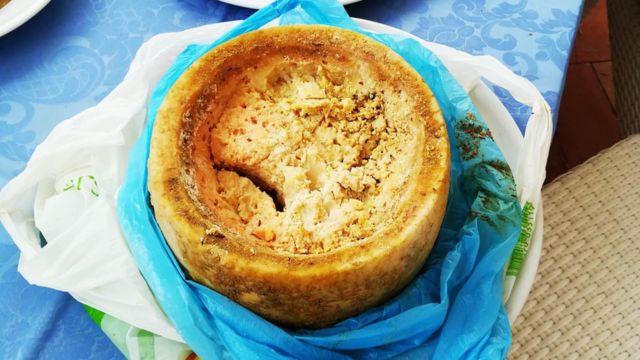In the diverse and often surprising world of cheese, one stands out not just for its flavor, but for its controversial and potentially hazardous nature. This is Casu Marzu, a traditional Sardinian sheep’s milk cheese that has garnered the title of the world’s “most dangerous” cheese. Let’s explore this unique delicacy, its history, the risks associated with it, and its place in culinary culture.
The Origin and Nature of Casu Marzu
Casu Marzu originates from the Italian island of Sardinia. It’s a variation of Pecorino cheese but with a twist – it contains live insect larvae. The cheese is made by allowing cheese skipper flies to lay eggs in cracks that form in the cheese, usually a firm Pecorino. As the larvae hatch and move through the cheese, they break down the proteins, resulting in a soft, creamy texture.
The ‘Danger’ in Casu Marzu
The controversy and the notoriety of Casu Marzu arise from its maggot content. The larvae, if ingested alive, can potentially survive in the human stomach and cause myiasis, a parasitic infection. This condition can lead to severe abdominal pain, nausea, and other gastrointestinal disturbances. However, it’s important to note that there are no recent reports of myiasis directly linked to Casu Marzu consumption.
Legal Status and Cultural Significance
Casu Marzu has faced legal battles due to health concerns. In 1962, the Italian government deemed it illegal due to the prohibition of consuming food infected by parasites, with violators facing hefty fines. However, in Sardinia, it has been reclassified as a “traditional food”, making it somewhat exempt from these regulations. Despite its illicit status in many regions, Casu Marzu remains a part of Sardinian heritage and culinary tradition.
Eating Casu Marzu: A Risky Delicacy?
The process of eating Casu Marzu is unique. It involves precautions such as wearing glasses to protect against larvae wiggling into one’s eyes. Some consume the cheese with the live maggots, while others suffocate them before eating. In Sardinia, Casu Marzu is often paired with strong red wine and consumed with bread. The flavor is described as intense, pungent, and lingering.
Safety and Health Concerns
The primary health concern with Casu Marzu is the risk of consuming live larvae. While there is a potential risk of myiasis, actual cases are extremely rare. The larvae themselves can jump up to 15 cm when disturbed, adding to the cautious approach required when handling the cheese.
The Cultural and Gastronomic Appeal
Despite the risks, Casu Marzu has a significant following. It’s considered a delicacy and an aphrodisiac in Sardinian culture. The cheese’s fame has even spread internationally, with adventurous foodies and renowned chefs showing interest in this unusual delicacy.
The Future of Casu Marzu
Efforts are ongoing to ensure the safety of Casu Marzu. Researchers are exploring controlled breeding of the cheese flies to reduce health hazards. This could lead to lifting bans and wider acceptance of the cheese while maintaining traditional production methods.
Conclusion
Casu Marzu stands at the intersection of culinary adventure and food safety regulations. Its story is a fascinating glimpse into a cheese that pushes the boundaries of conventional gastronomy. While it might not be everyone’s cup of tea, Casu Marzu remains a remarkable example of traditional food practices and the diverse world of cheese.
The tale of Casu Marzu is a testament to the rich and varied traditions that define our culinary world. Whether seen as a hazardous food or a gourmet delight, it undoubtedly adds a unique flavor to the cultural and gastronomic landscape of Sardinia and beyond. As the debate over its safety and legality continues, Casu Marzu remains a symbol of the daring and diversity inherent in the world of food.




